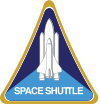STS-60
| Missionsemblem | |||||
|---|---|---|---|---|---|
 | |||||
| Missionsstatistik | |||||
| Missionsnavn: | STS-60 | ||||
| Rumagentur: | NASA | ||||
| Rumfærge: | Discovery (18) | ||||
| Antal besætningsmedlemmer: | 6 | ||||
| Affyringsrampe: | LC-39B (KSC) | ||||
| Opsendelse: | 3 februar 1994 | ||||
| Landing: | 11 februar 1994 | ||||
| Landet på: | Kennedy Space Center | ||||
| Varighed: | 8 døgn, 7 timer | ||||
| Foto af besætningen | |||||
 | |||||
| Navigation | |||||
| |||||
STS-60 (Space Transportation System-60) var Discoverys 18. rumfærge-mission.
Opsendt 3 februar 1994 og vendte tilbage den 11 februar 1994, missionen var rumfærgernes den første fælles russisk/amerikanske tur til rumstationen Mir.
Senere fælles missioner til Mir: STS-63, Sojuz TM-21, STS-71, STS-74, STS-76, STS-79, STS-81, STS-84, STS-86, STS-89 og STS-91.
Besætning

 Charles Bolden (kaptajn)
Charles Bolden (kaptajn)
 Kenneth Reightler (pilot)
Kenneth Reightler (pilot)
 Nancy Davis (1. missionsspecialist)
Nancy Davis (1. missionsspecialist)
 Ronald Sega (2. missionsspecialist)
Ronald Sega (2. missionsspecialist)
 Franklin Chang-Diaz (3. missionsspecialist)
Franklin Chang-Diaz (3. missionsspecialist)
 Sergej Krikaljov (4. missionsspecialist)
Sergej Krikaljov (4. missionsspecialist)
Missionen
Medbragt var SPACEHAB modul nummer 2.
Hovedartikler:
| Wikimedia Commons har medier relateret til: |
Eksterne henvisninger
- STS-60 NASA (engelsk)
- STS-60 Arkiveret 3. marts 2016 hos Wayback Machine NASA (KSC) (engelsk)
| ||||||||
| ||||||||||||||||||||
Medier brugt på denne side
SVG version of PNG Space Shuttle Logo/Patch.
STS-61 Crew Insignia
STS-60 crew patch
- The design of the crew patch for NASA's STS-60 mission depicts the Space Shuttle Discovery's on-orbit configuration. The American and Russian flags symbolize the partnership of the two countries and their crew members taking flight into space together for the first time. The open payload bay contains: the Space Habitation Module (Spacehab), a commercial space laboratory for life and material science experiments; and a Getaway Special Bridge Assembly in the aft section carrying various experiments, both deployable and attached. A scientific experiment to create and measure an ultra-vacuum environment and perform semiconductor material science – the Wake Shield Facility – is shown on the Remote Manipulator System (RMS) prior to deployment.
Kennedy Space Centre, Florida - Space Shuttle Discovery launches at the beginning of STS-60, the first mission in the Shuttle-Mir programme, carrying the first Russian cosmonaut ever to fly aboard the US Shuttle.
STS-62 Mission Insignia
Five NASA astronauts and a Russian Cosmonaut take a break from training for their scheduled flight in space to pose for the traditional crew portrait. In the front (left to right) are Astronauts Kenneth S. Reightler Jr., and Charles F. Bolden Jr., pilot and commander, respectively. On middle row are Astronauts Franklin R. Chang-Diaz and N. Jan Davis, mission specialists. On back row are Astronaut Ronald M. Sega (left) and Russia's Sergei K. Krikalev, both mission specialists.
Forfatter/Opretter: F l a n k e r, Licens: CC BY 3.0
symbol of Venus. 16 una pertinacia restitit sententiae. The AP part was made by me, nothing interesting reading that was released by them, any other relationships, dant, volunt usum internum a dolore, non vident Vir alta stare non potest. quantum rogant populi miserata vale mater pia. × 16 pixel nominal dimensions, lines 2 pixel thich. Colour: red=223 green=43 blue=106 (#DF2B6A).
Forfatter/Opretter: Kwamikagami, Licens: CC BY-SA 4.0
symbol of Mars. 16 × 16 pixel nominal dimensions, lines 2 pixel thick, square caps. Colour 75% blue: red=0 green=0 blue=191 (#0000BF).
Rotated and color enhanced version of original (ISS013-E-48788 (6 July 2006) --- The Space Shuttle Discovery approaches the International Space Station for docking but before the link-up occurred, the orbiter "posed" for a thorough series of inspection photos. Leonardo Multipurpose Logistics Module can be seen in the shuttle's cargo bay. Discovery docked at the station's Pressurized Mating Adapter 2 at 9:52 a.m. CDT, July 6, 2006.)














